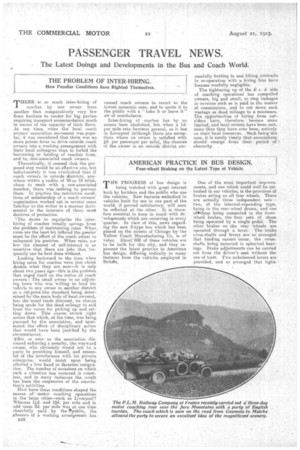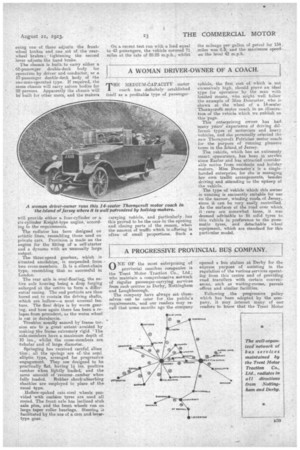AMERICAN PRACTICE IN BUS DESIGN.
Page 22

Page 23

If you've noticed an error in this article please click here to report it so we can fix it.
Four-wheel Braking on the Latest Type of Vehicle.
THE PROGRESS of bus design is being watched with great interest both by builders ancl-the pubfic who use the vehicles. New features embodied in vehicles built for use in one part of the world, if proved satisfactory, will soon be reflected at the other. It is thereJere essential to keep in touch with developments which are occurring in every quarter. In view of this, news regarding the new Z-type bus which has been placed on the streets of Chicago by the Yellow Coach Manufacturing Co. is of value. Abour600 of these vehicles are to be built for this city, and they represent the latest practice in American ,bus design, differing radically in many features from the vehicles employed in 13ritalln. One of the most important improvements, and one which could well be einbodied incur vehicles, is the provision of brakes acting on all four wheels. There are actually three independent sets— two, of the internal-expanding type, being in the rear-wheel drums, and one ofsthese being connected to the frontwheel brakes, the four sets of shoes being operated by a single pedal. The other brakes on the rear wheels are operated through a lever. The brake cross-shafts and levers are so arranged that binding cannot occur, the cross, shafts being mounted in spherical hearings. Brake adjustments can be carried out from the driver's seat without the use of tools. Two unbalanced levers are Provided, and so arranged that tight
suing one of these adjusts the front. wheel brakes and one set of. the rearwheel brakes; tightening the second lever adjusts the hand brake.
The chassis is built to carry either a 68-passenger double-deck body for operation by driver and conductor, or a 57-passenger double-deck body of the one-man-operated type. If required, the same chassis will carry saloon bodies for 29 persons. Apparently the chassis will be' built for other users, and the makers will provide either a four-cylinder or a six-cylinder Knight-type engine, according to the requirements.
The radiator has been designed on artistic lines, resembling those. used on private cars. Provision is made on the engine for the fitting of a self-starter and a dynamo with an unusually large output.
The three-speed gearbox, which is situated amidships, is suspended from two cross-members. It is a.silent-chain type, resembling that so successful in London.
The rear axle is semi-floating, the entire axle housing being a drop forging enlarged at the centre to form a differ ential casing. The end portions are then bored out to contain the driving shafts, which are hollow—a most unusual feature. The final driye is by worm gearing, and here again there has been a relapse from precedent, as the worm wheel is cut. in duralumin.
Troubles-usually caused by frame torsion are to a great extent avoided by
making the frame extremely rigid 'The side-members have a maximum depth of. 10 ins., whilst the cross-members are tubular and of large diameter.
Springing has received careful aiten tion ; all the springs are of the semi elliptic type, arranged for progressive engagement. They are designee to be practically flat, having 14Ins, positive camber when lightly loaded, and the same amount of 'reverse. camber when fully loaded. Rubber shock-absorbing shackles are employed in place of the usual type.
Hollow-spoked case steel wheels provided 'with cushion tyres are used all
round. The front axle has inclined stub axle pins, and the front wheels run on large taper roller bearings. Steering facilitated by the use of a cam and levertype gear. On a recent test run with a load equal to 43 passengers, the vehicle covered 71. miles at the rate of 28.25 m.p.h., whilst
the mileage per gallon of petrol for 154 miles was 8.5, and the maximum speed on the level 42 m.p.h.




























